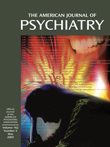To the Editor: The article by Jonathan Shedler, Ph.D., and Drew Westen, Ph.D.
(1), provides an excellent overview of the need to refine personality disorder diagnostic criteria. We would like to add some additional data about the complex diagnostic relationships between borderline and histrionic personality disorders in clinical practice.
Andalusia is the most highly populated region in Spain (7,606,848 inhabitants)
(2). The health care network in Andalusia, which serves the region’s entire population, comprises 17 psychiatric units for acutely ill patients in general hospitals.
As part of a wider study, we have been working with the Minimum Basic Data Set at Discharge From Hospitals
(3), a system of hospital record-keeping that records all patient discharges taking place at Andalusian hospitals.
It has been fully operational and reliable since 1995, and we have processed data up until 2002: 81,466 admissions in psychiatric units were recorded, with 12,919 receiving a diagnosis of personality disorder at discharge. The yearly total of borderline personality disorder diagnoses as a percentage of the total number of personality disorder diagnoses was as follows: 10.03% (1995), 10.27% (1996), 13.83% (1997), 16.22% (1998), 21.41% (1999), 17.18% (2000), 17.67% (2001), and 17.56% (2002). On the other hand, histrionic personality disorder accounted for the following percentages of all personality disorders: 25.75% (1995), 29.46% (1996), 16.98% (1997), 20.52% (1998), 16.78% (1999), 17.88% (2000), 17.96% (2001), and 19.17% (2002). The percentage of borderline personality disorder increased significantly over the first part of the period under study, whereas the percentage of histrionic personality disorder decreased over the same time period until the final years of the study when both percentages stabilized (the graphic representation of these percentages is nearly symmetrical around the x axis).
The sum of borderline personality disorder diagnoses plus histrionic personality disorder as a percentage of the total number of personality disorder diagnoses changed little over time: 35.78% (1995), 39.72% (1996), 30.80% (1997), 36.74% (1998), 38.18% (1999), 35.06% (2000), 35.06% (2001), and 36.72% (2002). Therefore, it is not at all unreasonable to think that a situation of “diagnostic transfer” has taken place over this period of time, moving from histrionic to borderline personality disorder.
One of the keys to this finding was provided by the results of Blashfield and Intoccia’s brief report
(4): the amount of literature on borderline personality disorder has experienced striking growth since the 1980s (after DSM-III), whereas the literature on histrionic personality disorder has declined since the mid-1970s. This situation has consequently influenced the practice of clinicians, including those in European countries.
New elements and conclusions can also be drawn from the excellent study by Drs. Shedler and Westen
(1): On one hand, as the authors interpreted the data, clinicians may not have clearly differentiated conceptions of the two personality disorders, leading them to be confused because of their high level of comorbidity, or, on the other hand, current diagnostic classifications should perhaps not maintain their current distinction between borderline and histrionic personality disorder.

